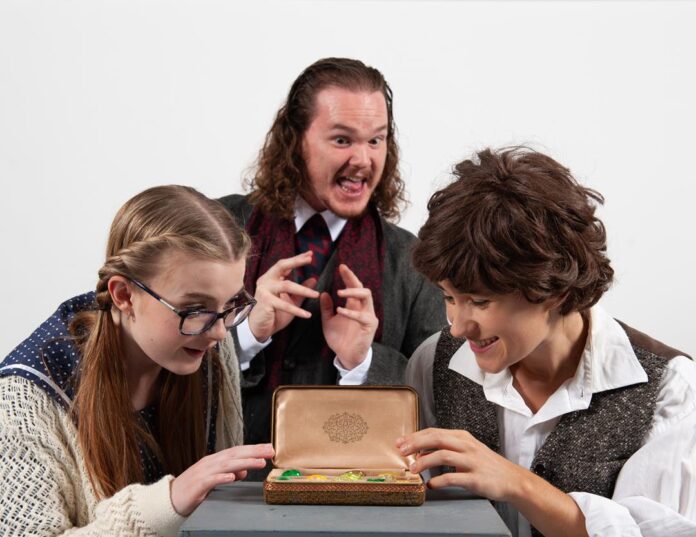I remember first listening to The Magician’s Nephew on CD when I was maybe nine years old. The radio drama captured my imagination in monumental and unique ways. I could close my eyes while listening to the performance and envision every scene with near total clarity in my mind. Having been raised in the church, I found the God-like character of Aslan a deeply comforting presence within the narrative. As an adult, the impact these stories have had on my imagination has only strengthened as I grow older and pursue creative writing. Over the years however, I’ve since disconnected from the central theology underlying The Magician’s Nephew. When Gallery 7 Theatre announced their 30th season with an adaptation of C.S. Lewis’ ambitious story, the nostalgia bug kicked in and I was eager to see their performance. The result was both spectacular, and conflicted.
For those unfamiliar with the source material, The Magician’s Nephew is a prequel to C.S. Lewis’ The Chronicles of Narnia series, which consists of seven books in total. While it was the second-last to be written and published, it serves as the first chronological book in the series. The story centers around a young boy named Digory, and his friend Polly who lives next door. One night, after being caught spying on the mysterious activities of uncle Andrew, Digory and Polly are sent on a multi-dimensional journey. The story ultimately introduces audiences to the creation of Narnia and establishes the character of Aslan, who acts as an allegory for the Christian God. The story involves numerous different locales and the traveling between different universes. It’s a monumentally ambitious story to successfully communicate in a live theater setting. To my amazement, Gallery 7 pulled this off astonishingly well.
Nearly every aspect of the production was perfect. The only blips occurred in the beginning with the actor’s microphones cutting in and out a couple of times, however it wasn’t a strong enough distraction to fully break my immersion. The different locales were communicated brilliantly by the primary use of stage boxes and projected images. The music and sound design pulled me right into the action. Without giving away spoilers for specific scenes, the use of simple stage props to communicate distance and travel adds a cinematic flair to the production. The cast do an excellent job with their characters, particularly Karis Duncalfe who plays the formidable central antagonist with her powerful stage presence. In regards to the production, Gallery 7 has achieved something they should be incredibly proud of.
My issue with this play really lies within C.S. Lewis’ story itself. Published in 1955, and written with the express purpose of working as a Christian ministry tool for children, the story feels outdated in a multitude of ways. I’m not in any way against the creative expression of one’s worldview. However, as the saying goes, show don’t tell. One of the most overt examples of this would be in a scene where Digory, Polly, and the winged horse named Strawberry are taking a break on their quest. Polly and Digory express their concern with the dangers they face as they run directly into an altercation with a supernaturally powerful witch. To close the conversation, Digory suddenly breaks out of an anxious funk to boldly state “So long as we’re flying with Aslan, we have nothing to fear!” Despite the fact that they aren’t flying with Aslan. They’re flying with Strawberry, running Aslan’s errands; saving his newly created world on his behalf. This moment of dialogue in the context of the story feels decontextualized and forced.
Other ways that the original story feels dated are in its representation of gender roles. Female characters are generally reduced to either antagonists or supporting roles for the men in the story. The two primary women in the story are Polly and the evil witch Jadis. After spending most of the story being belittled by Digory and/or needing rescuing, Polly doesn’t provide much else to the narrative outside of supporting Digory in his quest for personal development. After an altercation in which Digory violently pushes Polly to the ground and hurts her arm, Aslan asks her “do you forgive him?” without asking whether or not she’s okay or what happened. She’s told to forgive Digory before he’s even asked to own up to his actions. After Polly forgives him, Aslan immediately moves on from the situation entirely and sends Digory on a redemption quest to save Narnia. This feels reductive and misogynistic at best. However, if they were hoping to accurately portray how women are often treated in patriarchal institutions, mission accomplished! Elsewhere, uncle Andrew’s alcoholism is treated exclusively as a comedic device, which comes across as wildly insensitive to those suffering from addiction.
Overall, Gallery 7 has produced an incredibly fine adaptation of C.S. Lewis’ classic story. The lighting, acting, costuming, stage design, and music are impeccably well done. The critiques of the overall story lie in the time period it was written and certain concepts not aging very well. If you have fond memories of The Chronicles of Narnia and want to see an immersive and thoroughly ambitious live theater adaptation, Gallery 7’s The Magician’s Nephew will provide you with a wonderful evening of entertainment. If you’re someone like me who feels nostalgic for the stories but disconnected from the theology, you may still find it an interesting albeit conflicted experience.
Disclosure: The Cascade was provided with complimentary tickets to this performance for the purposes of review.
Kellyn Kavanagh (they/he) is a local writer, photographer, and musician. They first started writing what they now know to be flash fiction stories in the third grade when they learned how to make little books with a couple sheets of printer paper and a stapler. Their work typically focuses on non-ficiton journalism, short horror fiction, and very depressing poetry.



